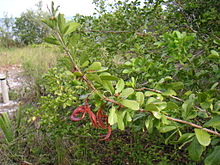Pithecellobiumis agenusofflowering plantsin thefamilyFabaceae.It includes approximately 23 species from the tropical Americas, ranging from Mexico to Peru and northern Brazil, including the Caribbean Islands and Florida.[1]
| Pithecellobium | |
|---|---|

| |
| Pithecellobium keyense | |
| Scientific classification | |
| Kingdom: | Plantae |
| Clade: | Tracheophytes |
| Clade: | Angiosperms |
| Clade: | Eudicots |
| Clade: | Rosids |
| Order: | Fabales |
| Family: | Fabaceae |
| Subfamily: | Caesalpinioideae |
| Clade: | Mimosoid clade |
| Genus: | Pithecellobium Mart.(1837), nom. cons. |
| Species | |
|
See text | |
| Synonyms[1][2] | |
| |
The generic name is derived from theGreekwords πίθηκος (pithêkos), meaning "ape" or "monkey," and ἐλλόβιον (ellobion), meaning "earring," which refers to the coiled shape of thefruit pods.[3]Plants of the genus are known generally asblackbeads.[4]
Species
edit23 species are currently accepted:[1]
- Pithecellobium × bahamenseNorthr.– Bahamas, southern Florida, and northern Cuba
- Pithecellobium bipinnatumL.Rico– Costa Rica
- Pithecellobium circinale(L.)Benth.– Cuba and Hispaniola
- Pithecellobium cynodonticumBarneby & J.W.Grimes– Haiti
- Pithecellobium diversifoliumBenth.– northeastern Brazil
- Pithecellobium domingenseAlain– Dominican Republic
- Pithecellobium dulce(Roxb.)Benth.–guamúchil,ebony blackbead, monkeypod –Mexico,Central America,northernSouth America
- Pithecellobium excelsum(Kunth) Mart.– Ecuador and Peru
- Pithecellobium furcatumBenth.– southern Mexico, Guatemala, Belize, and Costa Rica
- Pithecellobium histrix(A.Rich.) Benth.– Bahamas, Cuba, and Dominican Republic
- Pithecellobium hymenaeafolium(Humb. & Bonpl. ex Willd.)Benth.– southern Mexico to Venezuela
- Pithecellobium johanseniiStandl.–Belize,Guatemala,andHonduras
- Pithecellobium keyenseCoker– Florida Keys blackbead – southern Florida, Bahamas, Turks & Caicos, Cuba, southern Mexico, Guatemala, and Belize
- Pithecellobium lanceolatum(Humb. & Bonpl. ex Willd.) Benth.– Mexico through Central America and Colombia to Venezuela
- Pithecellobium macrandriumDonn.Sm.– southeastern Mexico, Guatemala, and Belize
- Pithecellobium nicoyanum(Britton & Rose) Niezgoda & Nevling– Costa Rica
- Pithecellobium oblongumBenth.– southern Mexico and northern Colombia
- Pithecellobium peckiiS.F.Blake– Guatemala and Belize
- Pithecellobium roseum(Vahl) Barneby & J.W.Grimes–buche colorado– Colombia, Venezuela, Guyana, and northern and west-central Brazil
- Pithecellobium striolatumUrb.– Haiti
- Pithecellobium subglobosumPittier– northeastern Colombia and northwestern Venezuela
- Pithecellobium unguis-cati(L.)Benth.– catclaw blackbead – Mexico, Central America, Caribbean, Colombia, Venezuela, and southern Florida
- Pithecellobium velutinumBritton & Rose– western Mexico (Sinaloa to Michoacán)
- Pithecellobium winzerlingiiBritton & Rose– southern Mexico, Belize, and Honduras
Formerly placed here
editMany species now in the generaAlbiziaandAbaremawere formerly classified inPithecellobium.Other species previously included:
- Abarema cochliocarpos(asP. cochliocarpum)
- Archidendron bigeminum(asP. bigeminum,P. gracile,P. nicobaricum)
- Chloroleucon foliolosum(asP. foliolosum,P. grisebachianum,P. myriophyllumMalme,P. oligandrum)
- Pseudalbizzia decandra(asP. decandrum)
- Pseudosamanea cubana(asP. bacona)
- Zygia cognata(asP. cognatum,P. stevensonii)
- Zygia pithecolobioides(asP. pithecolobioides,P. reductum)
References
edit- ^abcPithecellobiumMart.Plants of the World Online.Retrieved 7 August 2023.
- ^"PithecellobiumMart ".Germplasm Resources Information Network.United States Department of Agriculture. 2007-10-05. Archived fromthe originalon 2009-05-07.Retrieved2010-01-27.
- ^Austin, D. F. (2004).Florida Ethnobotany.CRC Press. p. 517.ISBN978-0-8493-2332-4.
- ^Pithecellobium.Integrated Taxonomic Information System (ITIS).
- Media related toPithecellobiumat Wikimedia Commons
- Data related toPithecellobiumat Wikispecies